Read by Matilda Longbottom
Winter can feel like the end of the gardening season, especially for those of us who rely on fresh produce from our backyard plots. But for the dedicated gardener, Winter doesn’t need to stop you from enjoying homegrown vegetables, herbs, and even edible flowers. With a hydroponic garden, you can keep your green thumb active all Winter long—right inside your home.
I have been dabbling in hydroponic gardening with the use of several different systems for a decade now, and I have to say there’s nothing like having a dining room wall that’s a bright beam of light illuminating 20 heads of lettuce. Because yes, folks, that’s what my hydroponic system looked like for several years until I got too tired of cleaning the tubes between growth cycles and went more simple. But still, produce grown in any hydroponic system is still my favorite produce of all, and mostly because it’s generally free of pests and poo!
Now that you’re totally appetized, let’s discuss how it’s done.
What Hydroponic Gardening Looks Like on a Consumer Level
Hydroponic gardening at home isn’t as complex or large-scale as the commercial setups used in agriculture. In fact, consumer hydroponic systems are designed to be compact, user-friendly, and efficient, allowing anyone to grow fresh produce in their home without much fuss. Most consumer hydroponic systems are small enough to fit on a kitchen countertop, a sunny windowsill, or in a corner of a room with enough light.
These systems typically use water as the primary medium for nutrient delivery. Instead of soil, the plant roots are suspended in water or a lightweight growing medium like coconut coir or clay pebbles. The water is enriched with a nutrient solution, which provides the plants with everything they need to thrive. Many systems are automated, meaning you don’t have to worry about managing the water levels, nutrient balance, or light—perfect for busy gardeners or beginners.
Brands like Gardyn and Click and Grow are well-known for offering stylish, functional systems that come with pre-seeded pods, making it as easy as plugging in the device, adding water, and letting the plants do their thing.
Now, let’s dive into the best edible plants to grow hydroponically in a small consumer-sized device, starting with an obvious favorite: lettuce.
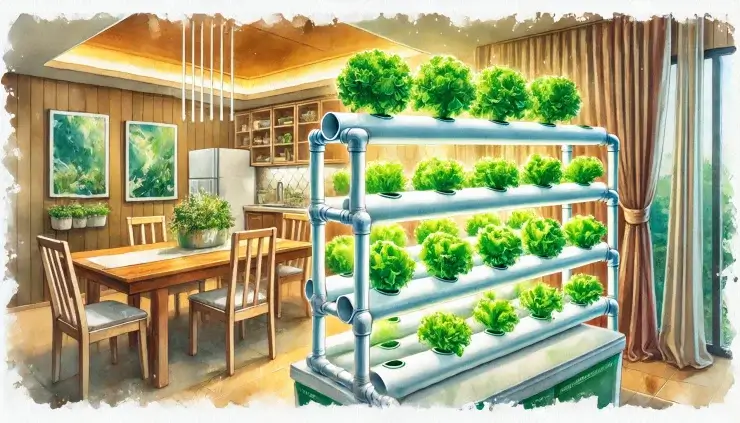
1. Lettuce
Lettuce is by far one of the easiest and most practical plants to grow hydroponically. It thrives in water-based systems and grows rapidly, making it ideal for home gardeners who want a continuous supply of fresh greens. One of the key benefits of growing lettuce hydroponically is that there’s no risk of bird droppings or soil contamination, which can sometimes be an issue when growing lettuce outdoors. Plus, you can trim the outer leaves as needed for salads, and the plant will keep producing new leaves. After a few rounds of harvesting, the leaves might start getting smaller or lighter in color, signaling it’s time to replant. But for the first several harvests, you’ll have fresh lettuce on demand without having to re-seed.

2. Spinach
Spinach is another excellent leafy green that grows well in hydroponic systems. Like lettuce, spinach loves the constant access to water and nutrients that hydroponics provides. You’ll find that spinach grown hydroponically tends to be more tender and flavorful than soil-grown spinach. Another bonus is that there’s no risk of soil-borne pests, and you can enjoy multiple harvests from the same plant, just by trimming off leaves as you need them. This makes it a convenient and low-maintenance crop for Winter gardening.

3. Herbs (Basil, Mint, Cilantro, and Parsley)
Herbs are some of the best plants to grow hydroponically due to their small size and fast growth. Basil is particularly well-suited for hydroponics—it grows quickly, and the more you trim it, the more it produces. Fresh basil is a great addition to Winter soups, sauces, and salads, and growing it hydroponically means you can avoid the disappointing limp basil from the grocery store.
Mint and cilantro also thrive in hydroponic systems. Mint can grow aggressively, even in water, so you’ll have a steady supply for teas, desserts, and savory dishes. Cilantro, which has a shorter lifespan, benefits from the consistent moisture and nutrients, growing faster and with less chance of bolting prematurely.
Parsley, though a slower grower, benefits from the same conditions and can be harvested continuously throughout the Winter months.
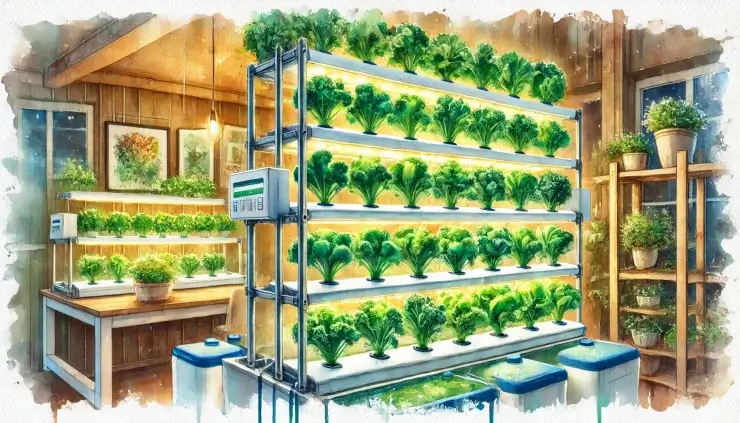
4. Kale
Kale is another leafy green that does well in hydroponic systems. It’s resilient, and like lettuce and spinach, you can trim the outer leaves while the plant continues to grow new ones. Hydroponic kale tends to be more tender and less bitter than kale grown outdoors, especially in the cooler months. Plus, it’s packed with nutrients like vitamins A, C, and K, making it a healthy and versatile addition to Winter meals.

5. Swiss Chard
Swiss chard is another hardy green that grows beautifully in hydroponic systems. It’s colorful, nutritious, and thrives in water-based environments. The plant’s striking red, yellow, and white stems add a vibrant touch to any indoor garden, and like kale, chard is great for clipping and growing multiple harvests. Hydroponically grown chard is particularly tender and less prone to pests than outdoor varieties.
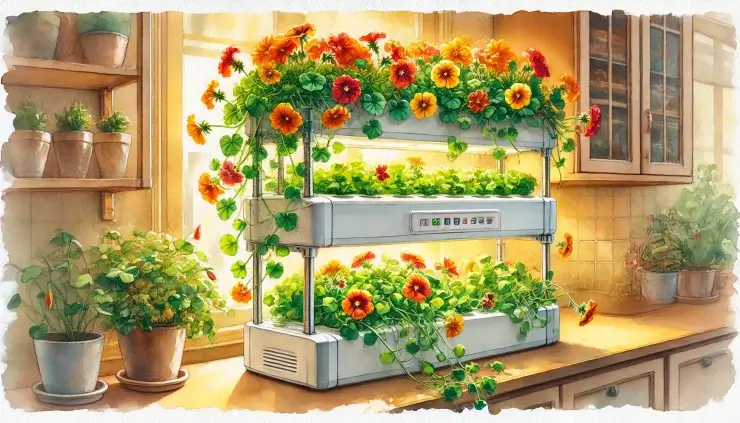
6. Edible Flowers (Nasturtiums)
For those who enjoy adding a pop of color and a peppery bite to their salads, edible flowers like nasturtiums are a wonderful addition to your hydroponic garden. Nasturtiums are not only beautiful, but they also grow well in water-based systems. They add a unique visual and flavor element to your meals, and because you’re growing them indoors, you don’t have to worry about pests or weather damaging their delicate blossoms.
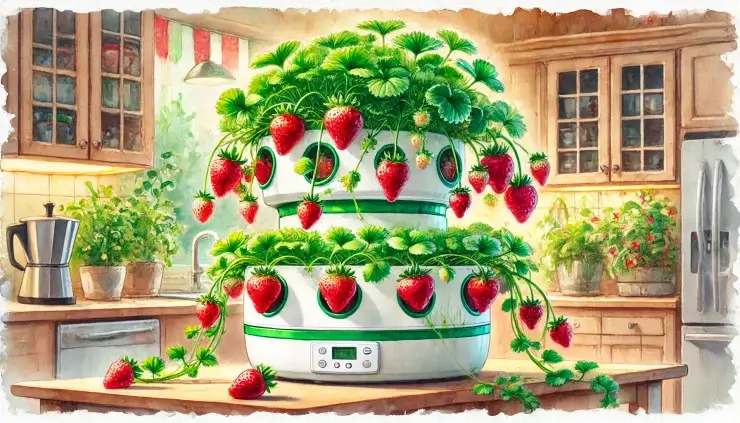
7. Strawberries
Strawberries might not be the first thing that comes to mind when you think of hydroponic gardening, but they’re surprisingly well-suited to it. Hydroponic strawberries can produce fruit year-round when given the right conditions. Since strawberries are typically grown outdoors in the Spring and Summer, having them indoors in the Winter feels like a treat. Plus, growing them hydroponically means you avoid soil diseases, and the fruits are often juicier and more flavorful.
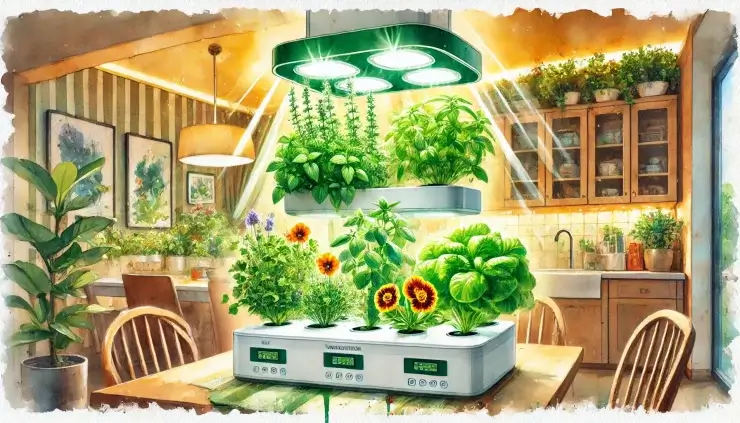
Let There Be Light!
The amount of light needed for a hydroponic garden varies depending on the type of plants you’re growing, but in general, most edible plants need between 12 to 16 hours of light per day to thrive. This is because, indoors, you’re trying to replicate the sunlight they would get outdoors. Hydroponic systems often come with built-in LED grow lights, which are energy-efficient and designed to provide the right spectrum of light for plant growth.
For leafy greens like lettuce, spinach, and herbs, 12 to 14 hours of light is typically sufficient. Fruiting plants like strawberries may need closer to 16 hours of light to promote flowering and fruit production.
If your hydroponic system doesn’t have built-in lights, place your garden near a bright window, or invest in full-spectrum LED grow lights to ensure your plants get the light they need, especially during the shorter daylight hours of Winter.
Nutrient Solutions
- Choose the Right Nutrient Solution: Use hydroponic-specific nutrient solutions that provide a balanced mix of essential nutrients. Brands like General Hydroponics or Botanicare are great options.
- Monitor pH Levels: Keep the pH of your solution between 5.5 and 6.5 for optimal nutrient absorption. Use a pH test kit or digital meter and adjust with pH up or pH down solutions as needed.
- Change the Solution Regularly: Replace the nutrient solution every 2 to 4 weeks to avoid nutrient imbalances. Always mix fresh nutrients when you change the water.
- Adjust for Growth Stages: Use lower nutrient concentrations for seedlings and increase it as plants mature. Look for “Grow” and “Bloom” labeled solutions for different plant stages.
- Check for Deficiencies: Watch for signs like yellowing or browning leaves, which could indicate a nutrient imbalance. Adjust the solution if necessary or do a full water change.
- Oxygenate the Water: Ensure your system has a pump or air stone to keep the water oxygenated, helping roots absorb nutrients efficiently.
These simple practices will help keep your hydroponic garden healthy and productive.
Hydroponic Gardening: A Winter Lifeline
Winter doesn’t have to mean the end of gardening if you’ve got a reliable hydroponic system. With the right setup, you can continue growing fresh, delicious, and healthy produce all Winter long, without the hassle of soil, pests, or unpredictable weather. Brands like Gardyn, and Click and Grow offer compact, efficient systems that take the guesswork out of indoor gardening. These systems are designed for busy gardeners who want a steady supply of fresh food without constant replanting or maintenance.
So, as the temperatures drop outside, your indoor garden can thrive, keeping you connected to the joys of gardening—and filling your kitchen with fresh, homegrown produce year-round.
What do you grow indoors in the Winter? I’d love to know!


 Previous
Previous



Amanda,
Thanks for replying… and I want to commend you on your beautiful illustrations, how gifted a girl are you! Writes as well as draws beautifully which is something I have wanted to do for years and is what’s stopping me from writing a whole host of children’s stories! I have heard that Click and Grow went out of business so I need to go back and see. I don’t buy my favorite iDOO brand because they don’t carry supplies any longer, yet units are still selling at Amazon, so I make sure to keep extra pumps and electric plug in devices in my “spares box!” I do know that Dak Ride is very much up and going and I have gone to them and had to throw an old Ivation away recently. I still don’t have the courage to start stacking, and for me that would be a lot of work, but I’m happy with the combination of units that I do have, and now 7 have come due and there’s more work ahead to clean and replant. Happy growing dear gifted girl!
Aw shucks, I couldn’t leave this one hanging, for me! I asked in my search strip at bottom left of computer, where can I find hydroponic units. Walmart came up so I went in. They have LOTS of units, LOTS of different brands with prices ranging from $49.99-0ver $101.00, stackables cost more, plus Walmart has a lot of supplies, racks with lights, et, al. It was all like eye candy for me who has to stop at 10 tabletop units for now, and do I dare stack??? I’d love to grow cucumbers and such but it would mean more money, time and work but I’d love to try it one day. I highly encourage hydroponic growing for those of us who can no longer get to the ground and dig into Mother Earth-something very much missed by me! I haven’t searched all at Amazon or other special dealers but with Amazon you pay no shipping if you’re a Prime Member.
Perhaps it would be a good idea for someone more knowledgeable then me, to come in here and let us know what hydroponic systems are still available! I only know that you can’t get parts for iDOO but they are still selling at Amazon. Rusirly, with a side tank sectioned off is used to fill up with plain distilled water and is used with the atomizer that comes with it. Dak Ride is still selling at Amazon and is praise-worthy. Maybe it would be wise to do a search for what is actually still selling. I still love your article and can see that a lot of effort was put into doing it and I love your illustrating, Amanda!
Hi Mo, Aerogarden is the only one that will be going out of business on January 1st, the others are alive and well. I love my Gardyn, though it takes a lot more work, and Click ‘n Grow is a lot easier, just let you can grow at once. Both are having Black Friday sales right now if you look on their websites!
Bok Choy-in just 6 pods grow beautifully in these units and is delicious in stir fry. I harvest big colanders full.
Cilantro also grows well along with many other herbs and plants. I have a unit full of mini red bell peppers-half picked, lots given away and more ripening as I write, and another unit full of bell peppers now turning red. I have given my doctor many peppers and jars of pickled one too. He loves the Hungarian Hot Wax yellow peppers that grow prolifically in these units. This is a very good article even if some companies have now gone out of business. A person can still find more units, like I said above, the Dak Ride brand is proving to be a worthwhile purchase.
This is a wonderful, wonderful article, Amanda! The artwork is also awesome. Since I can no longer grow outside which was very taxing since I live in the South, the heat, humidity and pests are more than a gardener can endure most times. I now have 10 smaller units-not those stacked like I see in your article. I have iDOO, Aero Garden, Ivation and Dak Ride. So far the Dak Ride brand is absolutely wonderful, very dependable and I like the fact that I can hear the pumps running. Amazon supplies the Dak Ride and if you’re a Prime Member, shipping is always free! Some brands have gone out of business or you can’t get parts for them any longer-the iDOO is one. I didn’t realize the Aerogarden went out of business-they really had good units. My tables in this office are covered with units. I found room in the Foyer for two more units and now two across from the fridge are putting out Anaheim and soon, mini bell peppers. The only problem I am having even when ordering dwarf seeds-the plants still seem to grow above the lamps! Look for my story in January in this online publication, “Hydroponic Growing For A Hydrophobic Gardener.” It’s not as instructive as yours is here but you may enjoy my silly sense of humor. Thank you for writing such a wonderful article!
Aerogarden has gone out of business and click and grow no longer available, they sold those off last year…. Spinach is hard to germinate in Hydro systems, not too many people are successful in growing it indoors This article is very past its sell by date.
Hi Valerie, thank you for your comment. Aerogarden will be closing on January 1st, but it appears units are still available for sale around, it might be a good time to get a good deal. I’ve had mine for years and use my own seeds, so they’re still viable to use once they formally close.
Click & Grow is also still in business and available on their own website and on Amazon, and it is currently having a Black Friday Sale.
I’m not sure about Spinach, I have grown it pretty reliably in my hydroponic gardens, with no more difficulty than other greens, I have not heard it to be hard to germinate, though I use rockwool almost exclusively and find it holds up pretty well for germination.